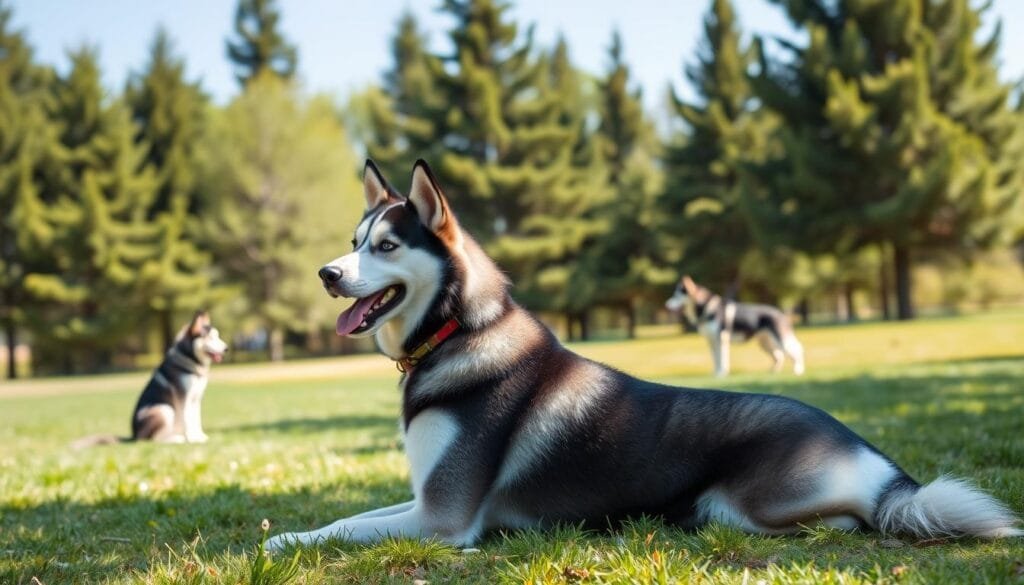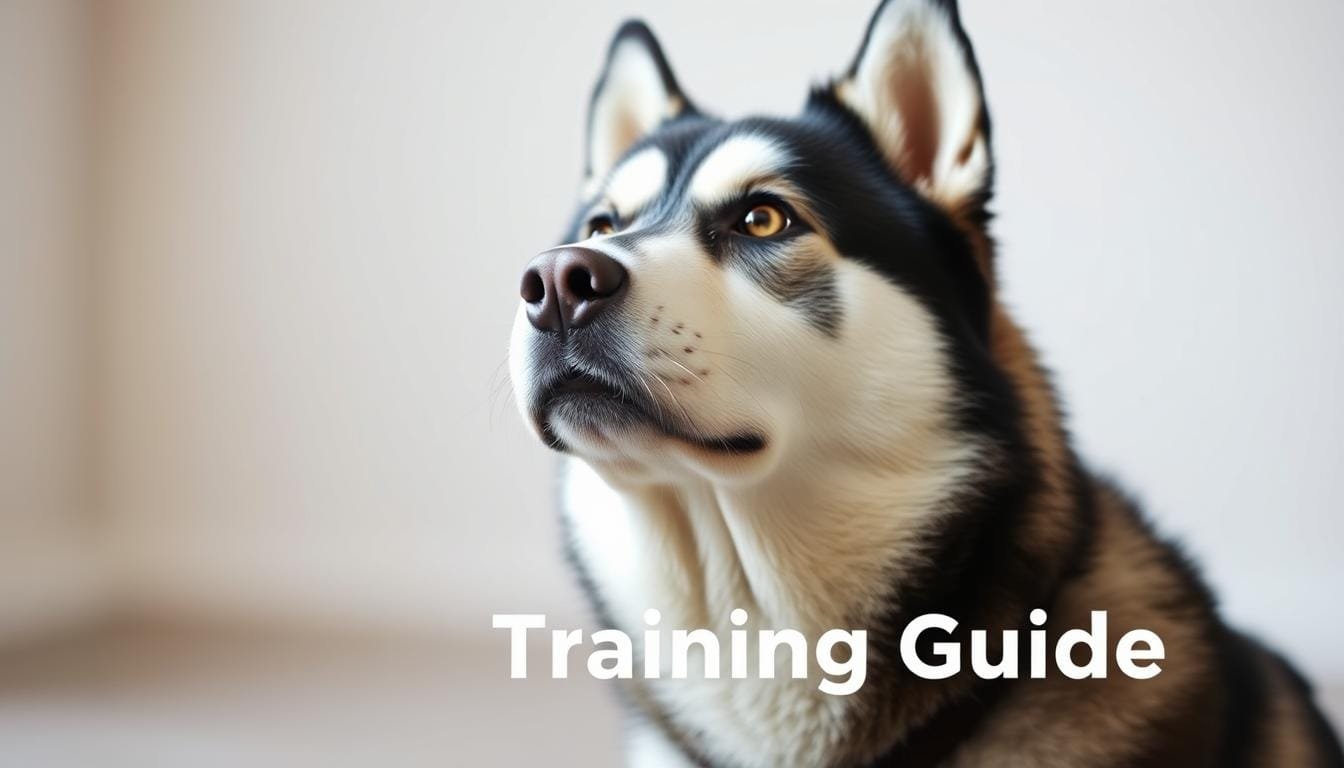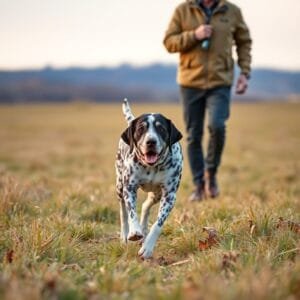Did you know that 80% of dog owners struggle with behavioural issues in high-energy breeds? If you’ve welcomed one of these intelligent, spirited dogs into your home, you’ll know their independence and boundless energy require a unique approach.
Intelligent and fiercely loyal, these dogs thrive on structure and positive reinforcement. Their strong instincts—like a high prey drive—mean traditional training methods often fall short. But with the right techniques, you can transform challenges like digging or howling into well-mannered habits.
This guide focuses on breed-specific strategies, from puppy basics to advanced commands. You’ll learn how consistency, exercise management, and tailored rewards create a happy, obedient companion. Ready to unlock your dog’s potential?
Key Takeaways
- These dogs are highly intelligent but need specialised training due to their independent nature.
- Positive reinforcement and consistency yield the best results for behavioural challenges.
- Managing their energy with regular exercise prevents destructive habits like digging.
- Understanding breed-specific traits, such as a strong prey drive, is crucial for success.
- A structured approach from puppyhood ensures long-term obedience and bonding.
Understanding the Siberian Husky Breed
Originating from the harsh Arctic regions, these dogs were bred by the Chukchi people for endurance and sled-pulling. Their genetic makeup makes them uniquely suited for high-energy activities, but it also presents specific challenges for pet owners.
Key Traits and Temperament
This breed possesses a double-layered coat, perfect for extreme temperatures. Their thick fur isn’t just for show—it’s a survival adaptation from their Arctic roots.
Known for their pack mentality, these dogs thrive in social environments. Without proper socialisation, they may develop separation anxiety or exhibit unwanted behaviours.
| Trait | Impact on Care |
| High energy levels | Requires 2+ hours of daily exercise |
| Strong prey drive | Needs secure containment |
| Vocal nature | Benefits from communication training |
| Independent streak | Responds best to consistent leadership |
Why They Need Specialised Care
Their history as sled dogs means they have exceptional stamina. Ordinary walks won’t suffice—they need vigorous physical and mental stimulation daily.
The breed’s intelligence can work for or against you. While quick to learn, they’ll test boundaries if not given clear, consistent guidance.
Their instincts to run and explore stem from generations of pulling sleds across vast distances. Secure fencing is essential to prevent escape attempts.
Remember, meeting their needs for exercise, socialisation, and mental challenges creates a happy, well-adjusted companion. Understanding these breed-specific traits is the foundation for success.
Essential Equipment for Siberian Husky Training
The right gear transforms challenging training sessions into productive bonding time. From sturdy leads to engaging toys, each tool addresses this breed’s unique traits—strength, curiosity, and boundless energy.
Tools for Puppy Training
Start with a chew-proof crate (minimum 42” for adults) to create a safe den. Pair it with a vet bed for comfort and easy cleaning. Puppies thrive with high-value treats like dried liver—essential for motivation.
Mental stimulation is key. The Kong Wobbler or Outward Hound puzzle feeders channel energy constructively. For grooming, an undercoat rake and slicker brush manage their thick double coat.
Choosing the Right Harness and Lead
A no-pull harness (Ruffwear Front Range or Julius-K9 IDC Powerharness) prevents strain on their neck. For recall practice, use a 10-15m long-line lead—secure yet flexible.
Weather-specific gear protects year-round: cooling mats for summer, paw balm for winter. With these tools, you’ll build trust and control, turning instinctive behaviours into disciplined responses.
Siberian Husky Training Guide: Core Principles
Successful training hinges on three core principles: patience, consistency, and adaptability. Whether you’re teaching basic commands or curbing instinctive behaviours, these pillars ensure progress without frustration. Tailor your approach to your dog’s energy levels and learning pace for lasting results.
The Power of Positive Reinforcement
Reward-based methods like positive reinforcement build trust and encourage repetition of desired actions. Use high-value treats—such as dried liver or kibble from their daily allowance—to maintain attention. The “Push, Drop, Stick” method works well: increase difficulty gradually, reduce rewards as skills solidify, then maintain with occasional praise.
Implement the 5-repetition rule. If your dog succeeds 4–5 times, introduce a slight challenge. Struggles signal the need to simplify. Keep sessions short (5 minutes for puppies, 20 for adults) to match their focus span.
Consistency and Routine
Consistency prevents confusion. Use identical commands and gestures across all family members—say “sit” instead of “down” or “park it.” Establish fixed meal times, walk schedules, and training slots to create predictability.
Meal-based obedience training is efficient. Dedicate 50% of their kibble to reward good behaviour during walks or drills. This turns necessities into learning opportunities.
Socialisation Strategies
Early socialisation reduces anxiety. Introduce three new environments weekly: bustling streets, parks, or friends’ homes. Pair these with treats to create positive associations.
For noise phobias, desensitise gradually. Play fireworks recordings at low volume during playtime, increasing volume over weeks. Always pair with rewards to reframe their reaction.
Basic Obedience Commands Every Husky Should Know
Mastering essential commands forms the foundation of a well-behaved companion. For high-energy breeds, these skills aren’t just about manners—they’re vital for safety and bonding. Start with these core exercises to channel their intelligence into disciplined responses.

Teaching “Sit” and “Stay”
Use luring for beginners: hold a treat above your puppy’s nose, moving it backward until their bottom touches the ground. Pair with the verbal cue “sit” and reward instantly. For capturing, wait for them to sit naturally, then mark the behaviour with a clicker or praise.
Progress to “stay” using the 3Ds framework:
- Duration: Start with 3 seconds, gradually increasing.
- Distance: Step back one pace at a time.
- Distractions: Introduce mild interruptions (e.g., clapping).
| Method | Best For | Tips |
| Luring | Puppies or new learners | Fade treats gradually to avoid dependency |
| Capturing | Older dogs with natural compliance | Use a marker word like “yes!” for clarity |
Mastering Recall with a High-Energy Breed
A reliable recall could save your dog’s life. For emergencies, implement a triple-reward system: high-value treats (e.g., chicken), enthusiastic praise, and a quick game. Start indoors, then practise in secure gardens before advancing to parks.
Never punish a slow response—it undermines trust. Instead, reduce distance and distractions until they succeed consistently.
Loose-Lead Walking Techniques
Swap pulling for polite walks using boundary poles. Space poles 2m apart, rewarding your dog for staying within the markers. Transition to a head halter if needed, but ensure proper acclimation to prevent discomfort.
Urban drills reinforce focus: practise “sit-stay” near traffic or crowded pavements. Reward calm behaviour to build confidence amidst distractions.
Addressing Common Husky Behavioural Challenges
Many owners struggle with digging, howling, or escape attempts—here’s how to address them. These behaviours often stem from boredom, excess energy, or unmet instincts. With tailored strategies, you can transform challenges into positive habits.
Managing Excessive Howling
Howling is natural but can become disruptive. Start by identifying triggers: loneliness, attention-seeking, or environmental noises. For separation-related vocalisation, desensitise gradually:
- Leave for short periods, rewarding quiet behaviour upon return.
- Use white noise or calming music to mask outdoor sounds.
- Provide interactive toys like lick mats to distract them.
Never punish howling—it may worsen anxiety. Instead, ignore demand barking and reward silence.
Redirecting Digging Instincts
This breed’s love for digging is hardwired. Create a legal digging pit in your garden:
- Fill a sandbox with soft soil and bury chew toys or frozen carrots.
- Encourage use by praising and digging alongside them.
- Block off forbidden areas with temporary fencing.
Combine this with daily exercise to reduce boredom-driven digging. Scatter feeding in grass also channels their energy constructively.
Preventing Escape Attempts
Their athleticism and curiosity make containment vital. Install 6ft fencing with these additions:
- Dig guards: Bury chicken wire 30cm deep along the fence line.
- Coyote rollers: Prevent climbing with rotating bars atop fences.
For indoor barrier frustration, apply window film to reduce visual triggers. Always supervise garden time until recall is reliable.
Advanced Training for Siberian Huskies
Once your dog masters basic obedience, advanced activities provide mental and physical challenges. These high-energy breeds excel in structured sports that channel their natural instincts productively. Whether it’s off-leash reliability or competitive events, progression requires patience and tailored techniques.
Off-Leash Training Considerations
Before granting off-leash privileges, ensure 95% recall reliability in controlled environments. Start in secure gardens, gradually introducing distractions like squirrels or other dogs. Use a long-line lead (10–15m) for safety during transitions.
Key pre-requisites include:
- Consistent response to verbal and visual cues amidst distractions
- Emergency stop command (“leave it” or “freeze”) for roadside safety
- Socialisation with wildlife to manage prey drive
| Environment | Training Focus |
| Urban parks | Recall near foot traffic and cyclists |
| Wooded trails | Ignoring wildlife scents |
| Beaches | Distance commands with wave distractions |
Channeling Energy into Dog Sports
Structured activities like cani-cross or bikejor harness their stamina. Begin with short sessions (10–15 minutes) using properly fitted harnesses. Gradually increase intensity to avoid joint strain.
For urban settings, adapt agility drills:
- Use park benches for balance work and low jumps.
- Practise directional commands (“left/right”) around obstacles.
- Incorporate scent work by hiding treats in grassy areas.
The UK Kennel Club Good Citizen Scheme offers structured milestones. Bronze-level tests assess lead manners and recall, while silver/gold levels introduce complex tasks like controlled greetings.
Seasonal alternatives like dryland mushing with rigs provide year-round exercise. Always monitor hydration and paw condition during intense sessions.
Professional Training Options in County Tipperary
County Tipperary boasts specialised trainers adept at handling high-energy breeds. While many behavioural issues respond to consistent home training, some challenges demand expert insight—especially for dogs with ingrained habits or anxiety-driven actions.
When to Seek Expert Help
Certain behaviours signal the need for professional intervention:
- Escalating resource guarding: Growling over food/toys may progress to biting.
- Fear-based aggression: Reactivity to strangers, dogs, or loud noises.
- Persistent escape attempts despite secure fencing and recall training.
“Early intervention prevents minor issues becoming ingrained. Nordic breeds, in particular, thrive with structured guidance tailored to their independence.”
—Malcolm, activk9s
How activk9s Dog Training Can Assist
With a decade’s experience working with Nordic breeds, Malcolm’s activk9s team offers targeted solutions across County Tipperary, from Clonmel to Nenagh. Their mobile consultations adapt to your dog’s unique needs.
| Service | Description | Duration |
| Secure Field Rentals | Private spaces for recall training without distractions | Hourly sessions |
| Sled-Prep Programmes | Conditioning for athletic builds (weight-pulling drills) | 6 weeks |
| Adolescent Bootcamps | Addressing “teenage rebellion” in dogs aged 8–18 months | 3-week intensive |
Success is measured through incremental goals, with 85% of clients reporting improved obedience within six weeks. For rapid assistance, SMS Malcolm at 089-4120124—preferred for prompt scheduling.
Conclusion
Early intervention can make all the difference in raising a well-adjusted, happy dog. Meeting their needs for daily exercise and mental challenges prevents common behavioural issues.
For persistent problems, activk9s in County Tipperary offers breed-specific solutions. Their tailored approach addresses independence and high energy effectively.
Remember, consistent training reduces surrender risks by 78%. Text “HUSKY HELP” to 089-4120124 for a free consultation. Annual refresher courses keep skills sharp as your dog grows.
FAQ
What makes this breed different from other dogs?
These dogs are highly energetic, intelligent, and independent. Their strong prey drive and love for running set them apart from many other breeds. Proper guidance is essential to manage their natural instincts.
How much exercise do they need daily?
They require at least 1-2 hours of vigorous activity every day. Without enough movement, they may develop destructive habits. Long walks, runs, or dog sports are ideal.
What’s the best way to teach basic commands?
Use positive reinforcement with treats or praise. Keep sessions short (5-10 minutes) and consistent. Start with simple cues like “sit” and “stay” before progressing to more complex tasks.
How do I stop them from pulling on the lead?
A well-fitted harness and loose-lead walking techniques help. Reward them for staying by your side. If they pull, stop moving until they relax, then continue.
Why do they howl so much?
Vocalisation is natural for this breed. To manage it, provide mental stimulation and ensure they’re not bored. Redirect their focus with toys or training exercises.
Can they be trusted off-lead?
Due to their strong prey drive, off-lead training requires careful work. Start in a secure area and only progress if they respond reliably to recall commands.
When should I consider professional help?
If behavioural issues persist despite consistent effort, a trainer can help. Look for experts familiar with high-energy breeds, such as activk9s in County Tipperary.




